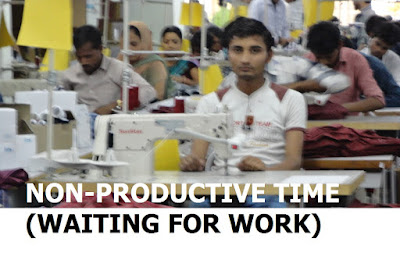Let discuss why we need to measure lost-time?
You may be thinking how this is possible? Let me assure you that this improvement is possible provided you know how much total time is lost in your factory and know how to convert those lost-time into productive time. Track improvement opportunities within your reach. Let me share how they did it.
Earlier they don’t have any measure for lost time data. They started using real time production system and instructed their operators to record lost-time when they don’t have work and when they sit idle for any other reasons. Operators are also instructed to enter lost-time reasons in the real time production tracking device. They have extensively captured lost time data in different categories. They analyzed data for one month. They got clear picture of major lost times and number of hours factory is wasting. They prepared plan to reduce top level lost -times categories and found good result in one month.
In the garment industry many factories don't know how much productive time they are losing every day. In case sewing operators and helpers are not working full 8 hours that means you have lost time.
Also read: 4 killer non-productive measures
Utilize operator’s time as much as you can. There is no better alternative than just stopping operators sitting idle, to improve operator productivity. Non-productive time such as waiting for work, machine breakdown, power failure and repair work kill your productivity. Start eliminating such non-productive time as much as possible. To start work on this point you have to track non-productive time data in different categories. Once you have the analysis and Pareto of non-productive time you can think and plan on reducing it.
Conclusion:
- To know the fact of the shop floor that how productive hours are lost and how many hours are lost on every day. Management just looks at the daily line efficiency data and labour productivity. But why efficiency and productivity is low in your factory? Major reasons are lost time.
- You can only manage (reduce) lost time in a line when you measure it and you have enough data for decision making.That's why you need to measure non-productive time.
- Unmeasured non-productive time is the potential area for productivity improvement. Productivity can be improved by reducing lost time.
- By tracking lost time and reducing it you can reduce the production lead time. At least you can be in position in shipping goods on time.
You may be thinking how this is possible? Let me assure you that this improvement is possible provided you know how much total time is lost in your factory and know how to convert those lost-time into productive time. Track improvement opportunities within your reach. Let me share how they did it.
Earlier they don’t have any measure for lost time data. They started using real time production system and instructed their operators to record lost-time when they don’t have work and when they sit idle for any other reasons. Operators are also instructed to enter lost-time reasons in the real time production tracking device. They have extensively captured lost time data in different categories. They analyzed data for one month. They got clear picture of major lost times and number of hours factory is wasting. They prepared plan to reduce top level lost -times categories and found good result in one month.
In the garment industry many factories don't know how much productive time they are losing every day. In case sewing operators and helpers are not working full 8 hours that means you have lost time.
Also read: 4 killer non-productive measures
Utilize operator’s time as much as you can. There is no better alternative than just stopping operators sitting idle, to improve operator productivity. Non-productive time such as waiting for work, machine breakdown, power failure and repair work kill your productivity. Start eliminating such non-productive time as much as possible. To start work on this point you have to track non-productive time data in different categories. Once you have the analysis and Pareto of non-productive time you can think and plan on reducing it.
Conclusion:
Do you measure non-productive time of the sewing lines in your factory? If you do, you are on the right track improving resources utilization and productivity. If not, you should start measuring non-productive time on the shop floor.
Also read: How to measure non-productive time (NPT)?
Also read: How to measure non-productive time (NPT)?


Post a Comment